With the seasons changing once again, as we reach the end of this calendar year, it is a time when I always ponder the conflict between what Nature does naturally, and how we humans deal with things.
I have mentioned this before, the logic seen from both sides, that whilst planting vegetables at the time of year when the temperature is cooler and there are less hungry bugs around does indeed make sense, except the reverse side of the coin asks me why we choose to plant things which subsequently require watering at a time when there is no rain, and thus we have to spend precious funds on equally precious water.
This year it has been wet on a little and often basis, and now that we are entrenched In the Cool (season), the pattern continues, with the weather being generally colder for a longer period of time, instead of a few intensely cold days. When I look around me, I can see what Nature intends; sleep, rest, recharging of her natural batteries, with days that are shorter, giving us more time to be quiet, be still. The plants that grow annually know what to do – depending on their type; some continue to flourish – especially those in semi shade, where night-time moisture provides more benefit than to those that are growing out in the open, in sunlight that is still quite hot and drying.
We have two levels of land here, the top level – which was built up with hard clay-like soil from our neighbour’s waterhole, supposedly to provide the base for a dwelling that I a guessing we will never actually see. Rather than ignore this infertile dirt, I have instead continued to do what comes naturally to me, regeneration of the land; piling on cow, pig and randomly chook manure, straw, old leaves, whatever it takes to get the soil into rehabilitation and back into working order, is finally paying off. It is a slow process, but that is the way of Nature. I try planting some things, but mostly end up nurturing what is there already or appears there by itself, thus demonstrating its preference for this kind of land.
The lower level is a different matter. It is the soil that was naturally in place to begin with. It is a loamy soil and sand mix, and was hard, dry and lifeless when I first moved here, due to the way it was treated. Now it is a thriving ecology, totally in control of its own self, with earthworms, birds, butterflies, and a further, far larger community of living things that the human eye does not see.
Now, in December, it is dry – many of the things growing there are over-wintering, and there is a lot of dead-looking grass and other vegetation. I still use this time to pile on piggy poo, and to keep an eye on how dry it is getting, but there is so much that is happy with how things are; a random watering of specific areas will happen at the times when I can see that the underground water level has dropped again – those recipient plants were put there by me, and thus I must take care of them. To a point.
Back in September, however, it was a different story to step into this herbal forest garden. I like to look back at photographs I took then, and admire what Nature can do.
Below is a tour of the garden, from the southern entrance, following what grows to the right, to the left, and then down to the north end. I will explain as I go….

Actually getting into the garden from this end, during the Wet season and surrounds, is a challenge in itself, as white turmeric continues to get bigger and bigger, with the once large-enough pots it was planted in surrendering to the expansion of the tuber system. I did consider replanting these tubers into the actual soil, but they seem happy where they are, semi breaking free, and also by keeping them in albeit broken confines helps to limit their spread. And they do spread.
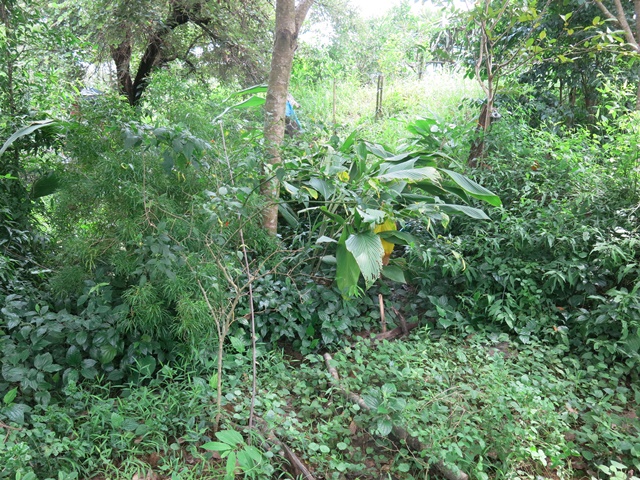
This picture shows that same white turmeric, and behind is the mesh gate, hidden from view. To the left of a rubber tree is a herbal shrub “ton leb khut” (ต้นเล็บครุฑ) that I have never used, but enjoy its company.
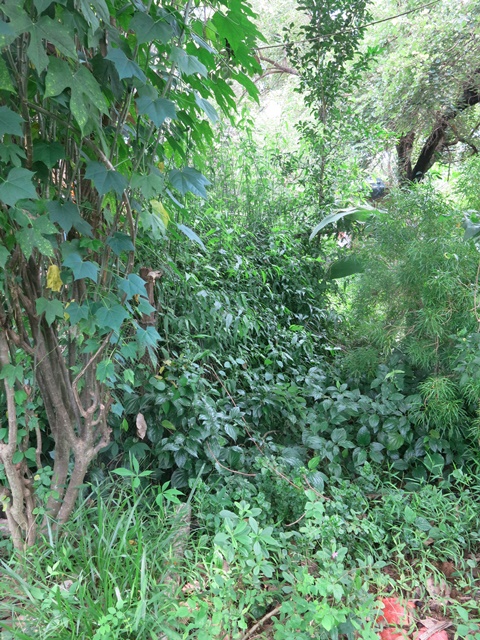
Due to the increase in shade – created by not only the rubber trees, but also the various herbal undergrowth around the fenceline, what used to be a patch of “phak ped khiow yaai” giant cress (ผักเป็ดเขียวไหญ่) is now home to a different kind of herb, known locally as “phak e-lert” (ผักอีเลิด). This loves the shade and damp, sends out runners to find both, and has a habit of taking over; the cress has instead packed its bags and started to migrate towards the next planting area which is in a lighter spot. To the left stands an edible herb, phak chaiyaa (ผักไชยา) that just grows taller and taller, branching out like an up-turned umbrella, and then generally falling over as soon as it meets a strong wind. No worries there, this grows anew just by looking at it, or so it seems!
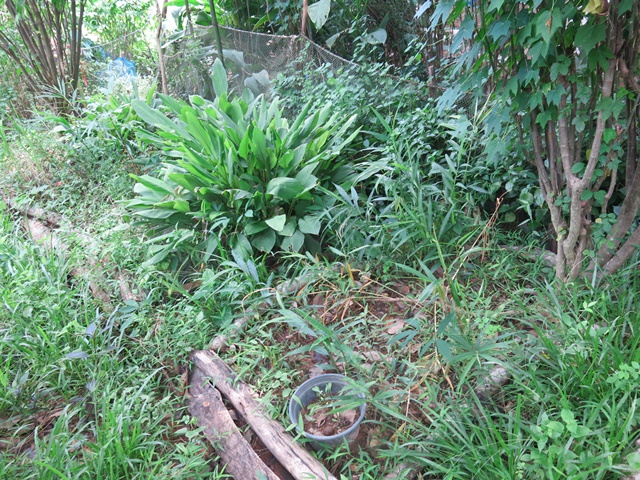
Next, still on the right side after entering from the south, is a bed where I used to do well planting beans, but as the rubber trees (and other vegetation) have grown, the shade has thus increased, and now only things that put themselves there really do well. Currently, ginger that I planted is still able to survive, but it won’t be long before it is once again too shady. Beyond this small area is a patch that is far lighter but also very dry – it always has been; the rhizome krachai (กระชาย – Boesenbergia rotunda) grows well here, as does butterfly pea, whilst ginger survives, and random roselle plants do their own thing – again, I no longer dedicatedly plant them there, but if their own seeds fall and they grow, well so be it.

To the left side of the southern entrance, a papaya plant grows as high as it can, in order to poke its crown out beyond the smothering branches and leaves of the rubber trees. It is possibly the only papaya I have actually planted myself that has succeeded – as opposed to self-setting in Miss Piggy’s poo, which is then spread over the soil, which is a sure-fire way of success. Surrounding it is another herb, “Waan Kab Hoy” (ว่านกาบหอย – Oyster Lily, White flowered tradescantia – Rheodiscolor Hance), which I put there not only because it likes this environment, but because of the beautiful contrast in colours. The tall fronds in the background are a beautiful red and yellow flower “Paak Nok Kaew” (ปากนกแก้ว – False Bird of Paradise – Heliconia rostrata), planted there as an experiment, as I could think of nowhere else to try; as you can see, it likes it there.
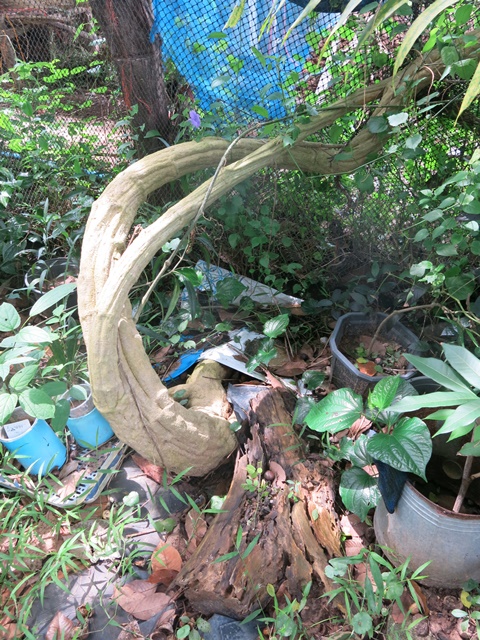
A close up of what has become an almost sculpture-like feature. This is the stem of a fast-spreading vine with a bright orange, spiny fruit (of the extremely bitter kind) called “fak khao” (ฟักข้าว – gac, spiny bitter gourd – Momordica cochinchinensis). What started as me carelessly dropping a seed on the ground has become this – worthy of a part in a Jack and Beanstalk production!
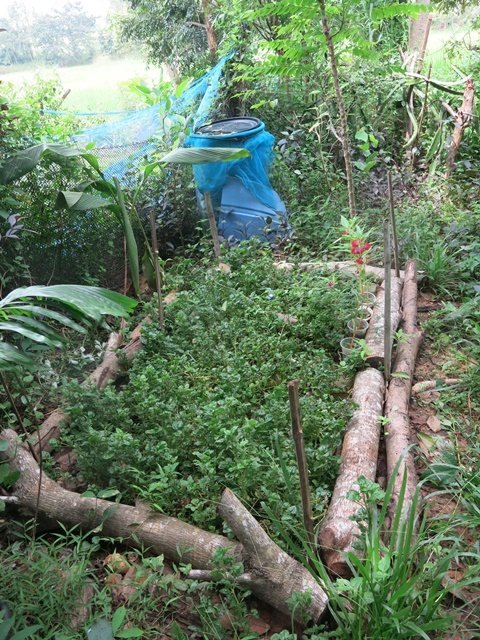
Near the far end is another bed of “phak ped khiow yaai” cress which I planted there myself. I used to fence it off with shadecloth attached to bamboo stakes, in order to keep it shady and to nurture a modicum of moisture if possible. Originally I did this, as there were eggplants (aubergines) trying to grow there – in earlier years they did exceedingly well, but more recently they have failed, almost as if the land is too rich for them now. Well, as the land dries out, it shrinks, and the bamboo stakes lean in wayward directions, and the intense power of the sunlight merely shreds the shadecloth. I got tired of forever having to re-do it all, and in the end decided to remove it all together. Instead, I found some conveniently aesthetically-pleasing logs – acquired from the piles left behind when the council did their annual roadside Pruning By Chainsaw, kept four corners of bamboo, and am subsequently enjoying a far nicer sight for the eye; during the Hot (season) I will put up a small but temporary canopy of shadecloth, if needed.

Finally, the view towards the north gate, hidden by the large phak chaiyaa shrub, and beyond that our rice fields.


Good to walk around your garden – fascinating. Like the style. More than half our garden is what you might call controlled wild – is that a fair description of yours? ie let things go much of the time, but not to the point they get out of hand.
LikeLiked by 1 person
Controlled wild. Yes, I like that description. I try not to interfere too much, but being in a confined space, and as you know how some elements of Nature like to take over vigorously, small touches are needed now and then.
LikeLike